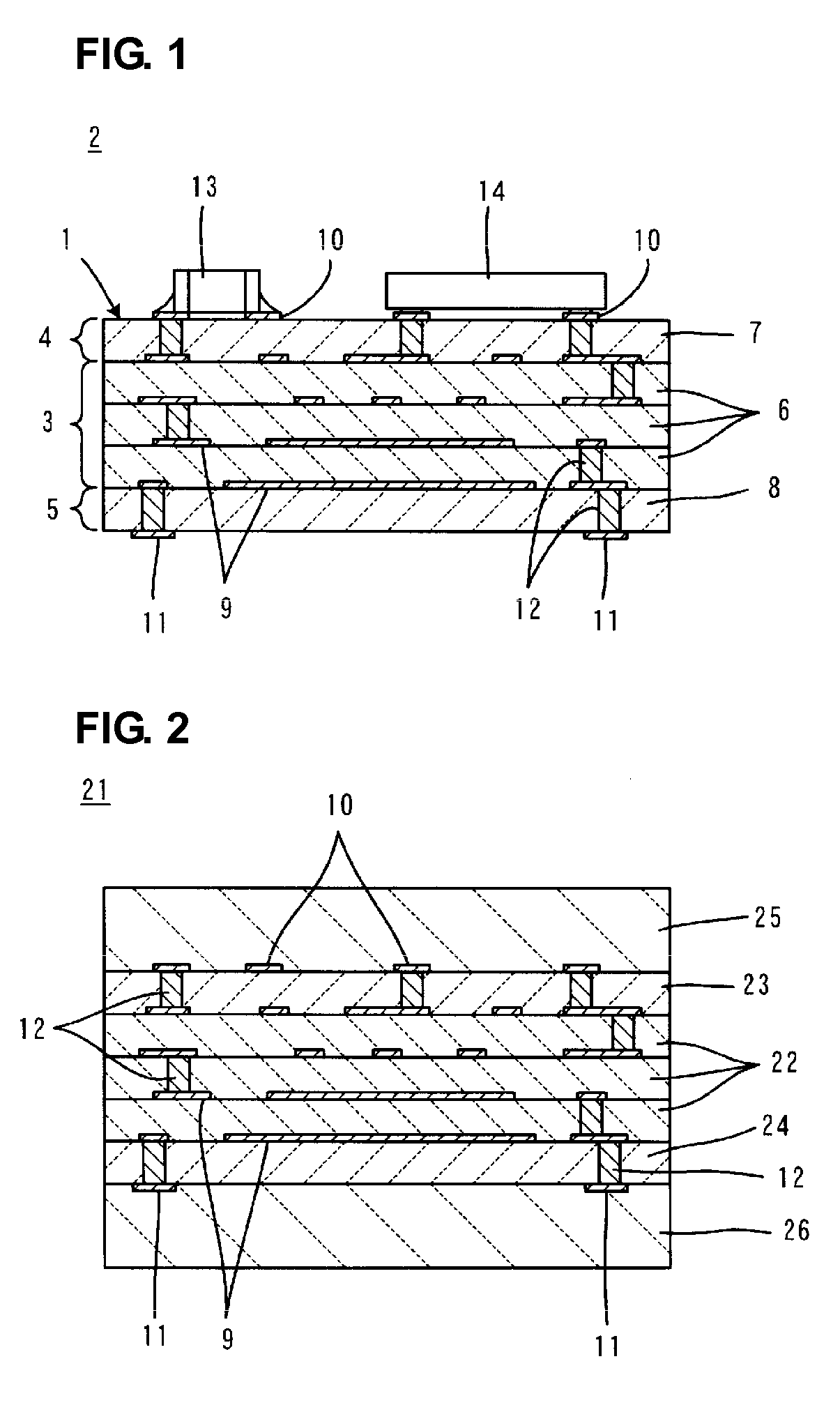Multilayer ceramic substrate, method for producing same, and electronic component
a multi-layer ceramic and substrate technology, applied in the direction of natural mineral layered products, solid-state devices, electrical devices, etc., can solve the problems of failure to disclose any limitations on the difference in thermal expansion coefficient, increase in the stress at the interface between the outermost layer and the inner layer, and delamination and voids. , to achieve the effect of reducing warpage and increasing strength
- Summary
- Abstract
- Description
- Claims
- Application Information
AI Technical Summary
Benefits of technology
Problems solved by technology
Method used
Image
Examples
experimental example 1
[0067]Surface ceramic green sheets and inner ceramic green sheets were prepared.
[0068]Table 1 shows the contents of a ceramic powder (in this experimental example, an Al2O3 powder was used) that functions as a filler and the compositions and the contents of glass powders in the surface ceramic green sheets. Table 2 shows the contents of a ceramic powder (an Al2O3 powder) that functions as a filler and the compositions and the contents of glass powders in the inner ceramic green sheets.
TABLE 1Ceramic green sheet for forming surface layerCeramicGlass powderSamplepowderSiO2B2O3CaOMgOZnOAl2O3TiO2SiO2:MO150455040100015.9:14.123030100203001018.0:12.03603820220105519.0:11.0440605152000018.9:11.1520605152000018.9:11.1640463014005523.0:7.0 750455040100015.9:14.18603820220105519.0:11.0940463014005523.0:7.0 105030100203001018.0:12.0114073423000022.8:7.2 1250605152000018.9:11.113603451610530017.0:13.01450545301100017.1:12.91540463014005523.0:7.0 165073423000022.8:7.2 1740601025005021.2:8.8 1850...
experimental example 2
[0083]Surface ceramic green sheets defining surface layers and inner ceramic green sheets defining inner layers were prepared.
[0084]Table 4 shows the compositions and the contents of ceramic raw material powders included in the surface ceramic green sheets. Table 5 shows the compositions and the contents of ceramic raw material powders included in the inner ceramic green sheets.
TABLE 4Ceramic green sheet forforming surface layerSampleBi2O3MgOCaONb2O5SiO221502003002250155300235010103002450812300254003525026401025250274010252502845525250294003525030350353003135035300
TABLE 5Ceramic green sheet forforming inner layerSampleBi2O3MgOCaONb2O5SiO2215030020022503002002350300200245030020025503501502655255150276020101502840525201029451515205304552025531450202015
[0085]To prepare the surface ceramic green sheets and the inner ceramic green sheets for samples 21 to 31, the ceramic raw material powders and water were sufficiently mixed. The mixture was dried and subjected to a heat treatment at abo...
PUM
| Property | Measurement | Unit |
|---|---|---|
| thickness | aaaaa | aaaaa |
| thickness | aaaaa | aaaaa |
| thickness | aaaaa | aaaaa |
Abstract
Description
Claims
Application Information
 Login to View More
Login to View More - R&D
- Intellectual Property
- Life Sciences
- Materials
- Tech Scout
- Unparalleled Data Quality
- Higher Quality Content
- 60% Fewer Hallucinations
Browse by: Latest US Patents, China's latest patents, Technical Efficacy Thesaurus, Application Domain, Technology Topic, Popular Technical Reports.
© 2025 PatSnap. All rights reserved.Legal|Privacy policy|Modern Slavery Act Transparency Statement|Sitemap|About US| Contact US: help@patsnap.com


